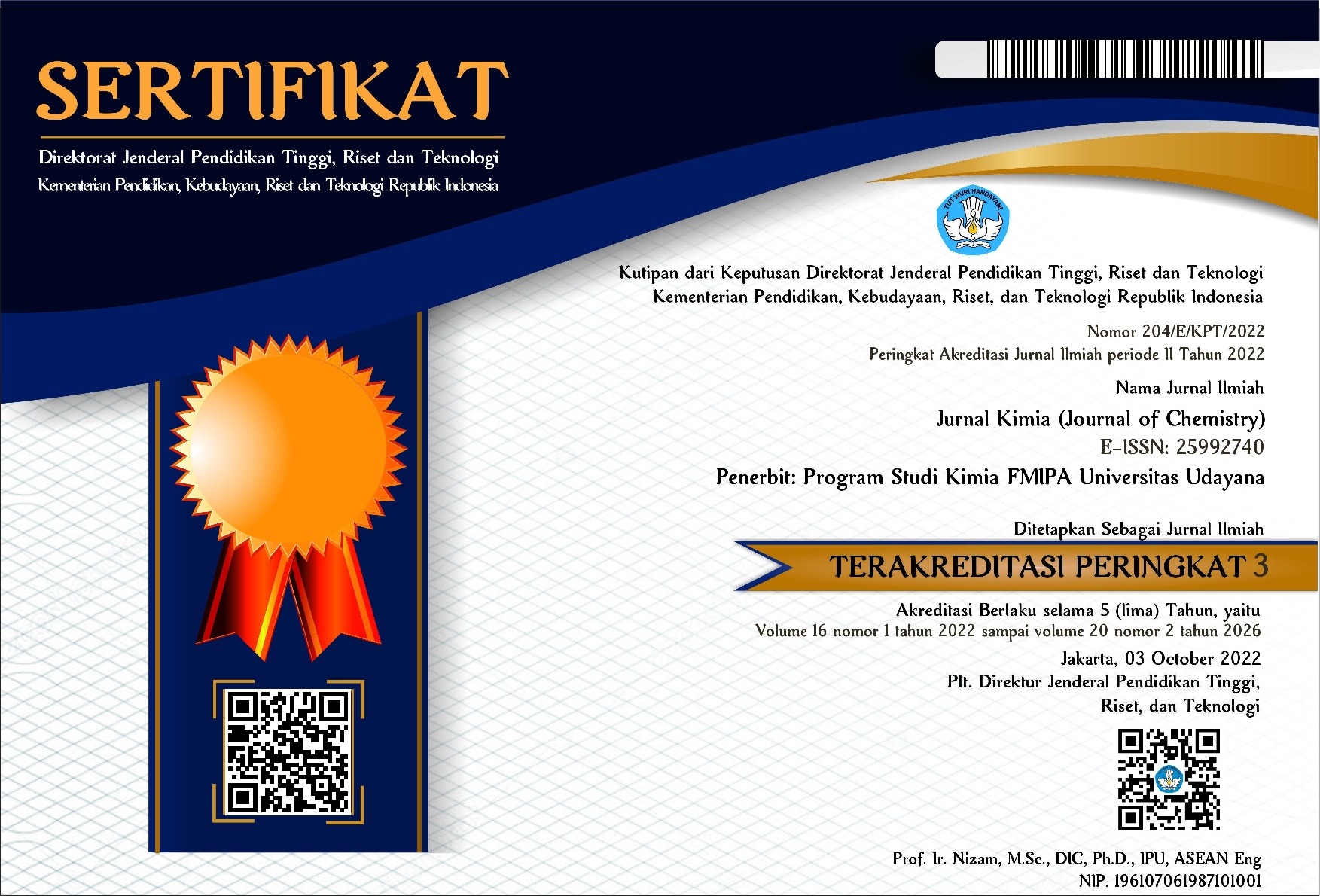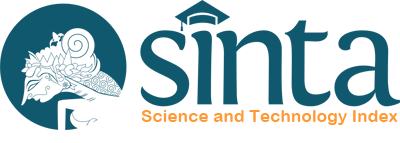EFEKTIVITAS ZEOLIT ALAM-TiO2/Fe2O3 DAN IRRADIASI ULTRAVIOLET DALAM PENURUNAN KONSENTRASI CAMPURAN METILEN BIRU DAN Cr(VI)
Abstract
Industri tekstil merupakan salah satu penghasil limbah cair yang mengandung berbagai zat warna sintetik dan logam yang sulit terurai seperti halnya metilen biru dan Cr(VI), sehingga dapat mengganggu ekosistem perairan. Penurunan konsentrasi campuran metilen biru dan Cr(VI) menggunakan zeolit alam-TiO2/Fe2O3 dengan irradiasi ultraviolet dilakukan dalam penelitian ini. Penelitian ini bertujuan untuk mengetahui konsentrasi, waktu penyinaran, dan pH optimum terhadap penurunan konsentrasi campuran metilen biru dan Cr(VI) dengan zeolit alam-TiO2/Fe2O3. Zeolit alam-TiO2/Fe2O3 yang disintesis dikarakterisasi luas permukaan spesifik secara BET, gugus fungsi dengan FTIR, dan jumlah situs aktif permukaan secara titrasi asam-basa. Karakteristik optimum diperoleh luas permukaan spesifik zeolit alam-TiO2/Fe2O3 (3:1) sebesar 16,902 m2/g, dan jumlah situs aktif sebesar 7,7171×1920 situs/gram. Hasil analisis gugus fungsional zeolit alam-TiO2/Fe2O3 menunjukkan adanya puncak khas yang teridentifikasi untuk zeolit alam pada bilangan gelombang 3636,56 cm-1; 1654,47 cm-1; dan 1055,10 cm-1, puncak spesifik TiO2 pada 797,60 cm-1 dan Fe2O3 pada 496,69 cm-1. Hasil penelitian menunjukkan bahwa konsentrasi optimum diperoleh pada perbandingan konsentrasi 1:1, waktu irradiasi 10 menit, dan pH 8 dan 4. Efektivitas penurunan konsentrasi metilen biru dan Cr(VI) 50 ppm menggunakan irradiasi sinar ultraviolet yaitu sebesar 99,98% dan 99,60%. Zeolit alam-TiO2/Fe2O3 dikategorikan efektif dalam menurunkan konsentrasi campuran metilen biru dan Cr(VI).
Kata kunci: Cr(VI), metilen biru, irradiasi ultraviolet, zeolit alam-TiO2/Fe2O3
ABSTRACT
Textiles are one of the producers of liquid waste that contains synthetic dyes and metals, such as methylene blue and Cr(VI), which are difficult to decompose and can disrupt aquatic ecosystems. This research investigated the reduction of a mixture of methylene blue and Cr(VI) using natural zeolite-TiO2/Fe2O3 with ultraviolet irradiation. This research aimed to determine the optimum concentration, irradiation time, and pH for reducing the concentration of a mixture of methylene blue and Cr(VI) with natural zeolite-TiO2/Fe2O3. The specific surface area of the synthesized natural zeolite-TiO2/Fe2O3 was characterized by BET, the functional groups by FTIR, and the number of surface-active sites using acid-base titration. The optimum characteristics of the synthesized natural zeolite-TiO2/Fe2O3(3:1) were the specific surface area of 16.902 m2/g, and the number of surface-active sites of 7.7171×1920 sites/gram. The results of the functional groups analysis showed that a typical peak was identified for natural zeolite at a wave number of 3636.56 cm-1, 1654.47 cm-1, and 1055.10 cm-1, respectively, and the specific peaks of TiO2 at 797.60 cm-1 and Fe2O3 at 496.69 cm-1. The research results showed that the optimum concentration was obtained at a concentration ratio of 1:1, irradiation time of 10 minutes, and pH of 8 and 4. The effectiveness of reducing the concentration of methylene blue and Cr(VI) of 50 ppm using ultraviolet irradiation was 99.98% and 99.60%, respectively. Natural zeolite-TiO2/Fe2O3 was categorized as effective in reducing the concentration of a mixture of methylene blue and Cr(VI).
Keywords: Cr(VI), methylene blue, ultraviolet irradiation, natural zeolte-TiO2/Fe2O3
Downloads
References
Fatimah, I., Sugiharto, E., Wijaya, K., Tahir, I., dan Kamalia . 2009. Titan Dioksida Terdispersi pada Zeolit Alam (TiO2/Zeolit) dan Aplikasinya untuk Fotodegradasi Congo Red. Indonesian Journal of Chemistry. 6(1):38-42.
Fu, J., Xin, Q., Wu, X., Chen, Z., Yan, Y., Liu, S., Wang, M. and Xu, Q. 2016. Selective adsorption and separation of organic dyes from aqueous solution on polydopamine microspheres. J. Colloid Interface Science. 461: 292-304
Islammiyati, A., Azwar, A., dan Asri, A. 2022. Studi Pengaruh Penyinaran Lampu Ultraviolet pada Kinerja Fotodegradasi Metilen Biru Berfotokatalis TiO2. Jurnal Prisma Fisika. 10(3): 430-435
Joshi, K.M., Shirivastva, V. S. 2010. Removal of Hazardious Textile dyes From Aqueous Solution by Using Commercial Activated Carbon With TiO2 and ZnO as Photocatalyst. International Journal of Chem Tech Research. 2:427-435.
Kongsong, P., Sikong, L., Niyomwas, S. dan Rachpech, V. Photocatalytic Antibacterial Performance of Glass Fibers Thin Film Coated with N-Doped SnO2/TiO2. The Scientific World Journal. 1-9.
Lestari, D.Y. 2010. Kajian Modifikasi dan Karakterisasi Zeolit Alam dari berbagai Negara. Prosiding Seminar Nasional Kimia. Universitas Negeri Yogyakarta. Yogyakarta
Lu, X., Wang, F., Li, X., Shih, K., and Zeng, E.Y. 2016. Adsorption and thermal stabilization of Pb2+ and Cu2+ by zeolite. Industrial and Engineering Chemistry Research. 55(32): 8767-8773
Oktapiani, N.K.A., Simpen, I.N., Negara, I.M.S. 2021. Fotodegradasi Rhodamin B Oleh Katalis Zeolit Alam-TiO2/ZnO Dan Irradiasi Sinar Tampak. Jurnal Kimia (Journal of Chemistry). 15(1):94-100.
Pauzan, M.A.B., Puteh, M.H., Yuzir, A., Othman, M.H.D., Wahab, R.A., and Abideen, M.Z. 2019. Optimizing ammonia removal from landfill leachate using natural and synthetic zeolite through statically designed experiment. Arabian J. for Science and Engineering. 45:3657-3669
Purnawan. C., Patiha., A.A, and Qodri. 2011. Fotodegradasi Zat Warna Remazol Yellow Fg Dengan Fotokatalis Komposit TiO2/SiO2. Jurnal Ekosains. III (1):17-23.
Saber, A., Rasul, M. G., Matens, W. N., Brown, R., Hashib M. A. 2011. Advances in Heterogeneous Photocatalytic Degradation of Phenols and Dyes in Wastewater: A Review. Water, Air, & Soil Pollution. 215 (1): 3 -29
Sarah, S., Nuraidah, S., dan Feranie, S. 2017. Hubungan Rentang Ukuran Butir Terhadap Besaran Batuan. Prosiding Seminar Nasional Fisika (E-Journal) SNF2017. 6: 89 – 94.
Slamet., Ellyana, M., dan Bismo, S. 2008. Modifikasi zeolit alam Lampung dengan Fotokatalis TiO2 melalui Metode Sol Gel dan Aplikasinya untuk Penyisihan Fenol. Jurnal Teknologi. 22(1): 59-68

This work is licensed under a Creative Commons Attribution 4.0 International License





